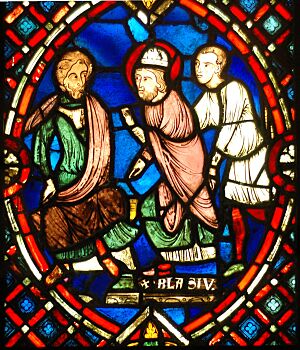Saint Blaise facts for kids
Quick facts for kids SaintBlaise of Sebaste |
|
|---|---|

|
|
| Hieromartyr, Holy Helper | |
| Born | 3 February (Eastern: 11 February) ? AD Sebastea, historical Lesser Armenia |
| Died | 316 AD (aged between his 30s and 40s) |
| Venerated in | Catholic Church Eastern Orthodox Church Oriental Orthodox Church Anglican Communion |
| Major shrine | St Blaise's Church |
| Feast | 3 February (Catholic, Anglican Communion)
Usually in January (date varies)(Armenian Apostolic) 11 February (Eastern Orthodox and Greek Catholic) |
| Attributes | Bishop, animals, crossed candles, tending a choking boy, wool comb |
| Patronage | Infants; animals; builders; stonecutters; carvers; drapers; wool workers; wool industry; veterinarians; physicians; healing; throats; the sick; against choking; ENT illnesses; Bradford; Salerno; Maratea; Sicily; Dubrovnik; Ciudad del Este, Paraguay; Campanário, Madeira; Rubiera and Sebaste, Antique. |
Saint Blaise (also known as Hágios Blásios in Greek) was a doctor and a bishop from a place called Sebastea. This area is now part of modern Sivas, Turkey. He lived a long time ago and was killed for his Christian faith around the year 316 AD. Because of his life and actions, he is honored as a Christian saint and a martyr.
Saint Blaise is special because he is one of the Fourteen Holy Helpers. These are saints who are believed to help people in many different situations. He is especially known as the patron saint of people who work with wool. He also helps those with illnesses of the throat, nose, and ears. In the Catholic Church, his special day is February 3rd. In Eastern Christian churches, it is February 11th.
Contents
Who Was Saint Blaise?
Saint Blaise was a very kind and wise person. He was known for being a healer. He helped people who were sick and also gave good advice for their spirits. It is said that he even helped animals! Animals would come to him when they were hurt or sick, and he would care for them. In return, the animals would sometimes help him.
He was the bishop of Sebastea. A bishop is a leader in the Christian church. Blaise taught people not just with his words, but also by living a good example. Many people believed he performed miracles because of his strong faith.
Early Stories About Saint Blaise
One of the first mentions of Saint Blaise comes from medical writings around the year 500 AD. In these old texts, people would ask for his help when someone had something stuck in their throat. This shows how early people believed in his power to heal throat problems.
Later, famous travelers also wrote about him. Marco Polo, a famous explorer, mentioned the place where Saint Blaise was martyred. Another traveler, William of Rubruck, also wrote about his shrine in 1253. These stories show how important Saint Blaise was to people throughout history.
His Final Days
Around the year 316 AD, there was a time when Christians were being persecuted. A Roman governor named Agricola, following orders from the Emperor Licinius, ordered Saint Blaise to be arrested.
Blaise was questioned and treated very harshly. He was then put in prison. Sadly, he was later beheaded, meaning he was killed by having his head cut off. He died for his faith.
Symbols of Saint Blaise
When you see pictures or statues of Saint Blaise, he often has special symbols.
- Crossed Candles: He is often shown holding two candles that are crossed. These candles are used in a special blessing called the Blessing of the Throats. This blessing happens on his feast day, February 3rd. It is believed to protect people from throat illnesses.
- Wild Animals: Sometimes, he is shown in a cave with wild animals around him. This is because hunters found him in a cave, and he was known for helping animals.
- Steel Combs: You might also see him with steel combs. These were tools used to torture him before he died. They look a lot like the combs used to prepare wool. Because of this, he became the patron saint of people who work with wool.
Saint Blaise is traditionally asked to help with throat problems, especially if someone has a fish bone stuck in their throat. He is also called upon to help with conditions like obstructive sleep apnea, which involves throat tissues blocking breathing during sleep.
See also
 In Spanish: Blas de Sebaste para niños
In Spanish: Blas de Sebaste para niños
- Blessing of the Throats
- Order of Saint Blaise
- San Biagio (disambiguation)
- Festivity of Saint Blaise, the patron of Dubrovnik
- The Bishop Blaize

